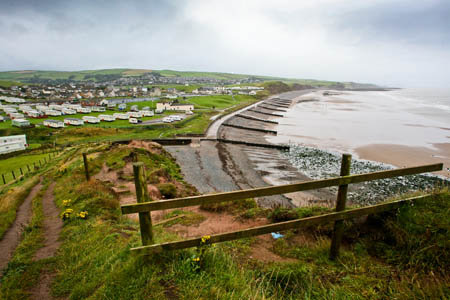England’s new coastal path should be the envy of the world, urged the Ramblers’ chief.
More than a third of the country’s coastline has no official rights and visitors are confused about where they can and can’t go, according to the organisation. Its chief executive called today for the Government to hold its nerve and press ahead with the proposed coastal access corridor.
The Ramblers say that, on average, a walker can go only 3km (two miles) before encountering an obstruction or diversion.
Tom Franklin, chief executive of the campaign group, said: “Today our beaches will be full of children building sandcastles or families strolling along beautiful vistas yet access to our coast is vulnerable and fragmented.
“The public needs the Government to hold firm and introduce legislation that will make access to our coast the envy of Europe and the world and boost small coastal businesses that are badly suffering during the recession.”
Natural England, the Government’s advisory body on the outdoors, is today publishing new maps of the English coast.
Dr Helen Phillips, chief executive of Natural England, said: “The news that the public lack full access to nearly 1000 miles of coastline is a sobering reminder of how much is at stake in the Marine and Coastal Access Bill.
“There are significant challenges ahead, but for millions of people, the Bill presents a unique opportunity to transform their enjoyment of England’s countryside.”
Poul Christensen, acting chair of Natural England, said: “With increasing numbers of people taking their breaks in Britain, it is encouraging that there will be more coastal destinations opening up for visitors in the future when the Marine and Coastal Access Bill is passed.
“Our audit looked at the different types of access that exist on the ground and the results show a stop-start effect.
“On average you cannot walk further than two miles without reaching an area of unsecure access or having to turn back. Plugging some of the gaps and improving access along almost 1,000 miles of coastline could add significant value to the way the coast is used.”
A spokesperson for the Ramblers said: “Our coast is one of the most heavily developed and urbanised in the world – there are over 120 seaside towns in all and almost one third of it is developed in one way or another.
“Another issue is private beaches. The Marine Conservation Guide to Good Beaches found about 170 private beaches in Devon and Cornwall. Devon County Council claimed that only three-quarters of their beaches have public access.”
The Ramblers say that, once Natural England has established the coastal corridor, the route will be given national trail status.
Examples of areas where there are problems for walkers on the coast include:
- The Holker Hall Estate in Cumbria, part of the Duke of Devonshire’s 30 350ha (75,000-acre) northern landholdings, which has no access to a portion of coastal land, forcing walkers on the Cumbrian Coastal Path to detour 6.5km (4 miles) inland.
- Pilling Bank, near Cockerham Sands, Lancashire. Here, the local authority has imposed a ban on all rights of way along the flood defences
- The Beaulieu Estate, Hampshire: although it accepts the right of way along the Beaulieu river estuary, there is no access to the adjacent beach.
- More than a quarter of the Durham coast path, near Horden, is ‘permissive’ and could be closed to access without notice, at any time.
- Filey: the Cleveland Way ends at this Yorkshire seaside town. From here on all routes are blocked by a number of private holiday villages.
- There is no legal pathway between King’s Lynn and Hunstanton, in Norfolk, and there is no public access from the point at Lynn to Snettisham Beach.
- At Osbourne House, the Isle of Wight coastal path is forced inland around the private beach that belongs to the English Heritage-owned stately home overlooking the Solent.
The Marine and Coastal Access Bill is currently making its way through Parliament. Earlier this month, the Country Land and Business Association, which represents landowners, expressed its relief at a Government pledge to exclude parks and gardens from the coastal access corridor.
CLA President Henry Aubrey-Fletcher said: “Even before this Bill, 70 per cent of the English coastline was available to walkers. The remaining 30 per cent is not accessible for very good reasons, namely ports, harbours, military bases and areas left for environmental purposes.
“This showed that it is perfectly possible to create coastal routes without impinging on private parks and gardens.”
The coastal maps can be viewed on Natural England’s website.


Simon
31 July 2009Yet again the Ramblers only care about England, no interest in Scotland at all. Cancel your membership to this disgraceful organisation now.
Bob
31 July 2009In fairness to the Ramblers, no campaign is necessary for the Scottish coast: walkers already enjoy coastal access north of the border under the Land Reform (Scotland) Act 2003. - Bob Smith, editor